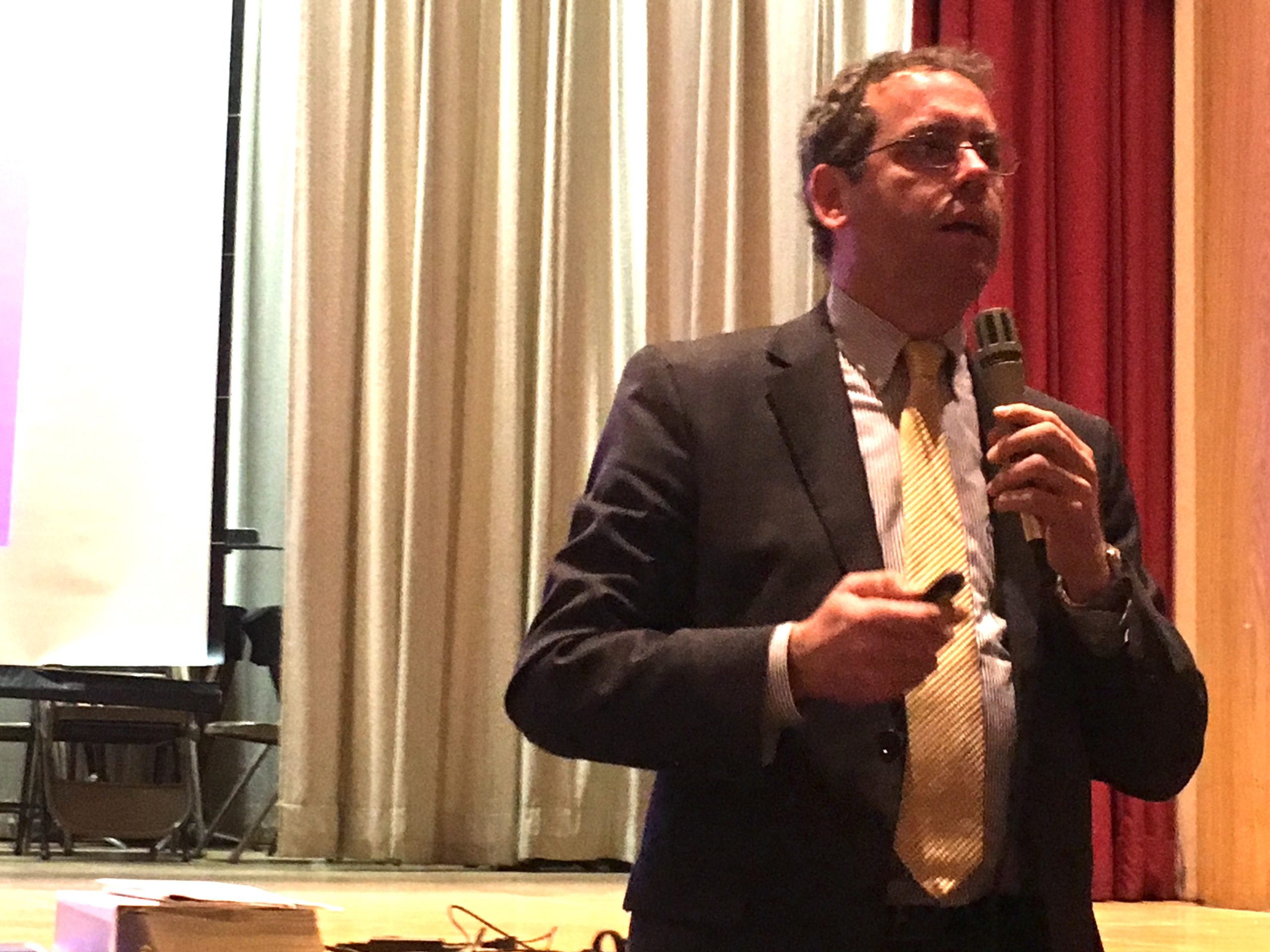Politics have bubbled underneath debates surrounding the Long Island Rail Road’s proposed third track since Gov. Andrew Cuomo announced it in January 2016.
New Hyde Park Mayor Robert Lofaro brought them to the surface last Thursday, charging that the second-term Democrat is using the $2 billion plan to fuel his political ambitions, including a run for president in 2020.
Cuomo’s strategy, Lofaro said, involves boosting a coalition of powerful interest groups and political allies — the Right Track for Long Island coalition — who stand to reap financial benefits from the project, while paying lip service to local concerns.
“He wants to win,” Lofaro told a crowd of about 150 people at a village-sponsored meeting at the New Hyde Park Road School. “It’s not about you, it’s about him.”
Lofaro digressed from his analysis of the draft environmental study the LIRR released in November to his view of how politics are fueling the long-delayed project.
Dave Kapell, Right Track for Long Island’s executive director, was at the meeting and said Lofaro’s statements were “strictly disingenuous.”
The coalition has been promoting the project for about four years and had been organizing support “behind the scenes” before Cuomo threw his full support behind it last year, Kapell, the former mayor of the Village of Greenport, said.
Its impetus was a 2012 study by the Rauch Foundation Long Island Index, a nonprofit group for which Kapell is a consultant, showing the benefits of the project, Kapell said.
“The governor’s involvement is a game-changer, there’s no question about it, and we welcome it,” Kapell said. “We don’t walk away from it.”
A 2014 Long Island Index study showed the third track would create 14,000 jobs and add $5.6 billion to Long Island’s gross regional product in the first 10 years.
The LIRR is holding public hearings this week on its proposed project, which would add a third track to a key 9.8-mile stretch of its Main Line between Floral Park and Hicksville.
Before the start of the first hearing Tuesday, Metropolitan Transportation Authority Chairman Tom Prendergast said it would lead to improved and increased LIRR service by giving trains a way around accidents that now cause delays across the railroad system.
But local elected officials and residents speaking in New Hyde Park last Thursday said they remain concerned about noise, traffic and other quality-of-life problems during the three- to-four-year construction period and after the project is finished.
Cuomo and the LIRR have described this plan as less invasive than one proposed 10 years ago, something Prendergast emphasized Tuesday. It will not take any residential property and will eliminate the seven street-level railroad crossings along the corridor, where traffic often backs up and deaths have occurred.
Feedback from transit agency leaders and evidence of railroad service patterns “sold” Cuomo on the third track’s significance and how important it is that it get done, said Prendergast, who will retire this year.
“My read of his focus is, this is an important public service improvement, infrastructure improvement that needs to get made, and he wants to lend his support to that, and his leadership,” he said.
Project planners have met constantly with local officials, community leaders and residents, adding project elements and changing others based on their feedback.
But despite those efforts over the past year, the plans have not thoroughly incorporated input from New Hyde Park officials and would still change the character of the village, Deputy Mayor Lawrence Montreuil said.
Meanwhile, the “well-funded” Right Track for Long Island coalition, comprising labor unions, business groups, nonprofits and universities, has been “blitzing” the public to try to win support, Lofaro said.
While supporters have touted the third track as an economic boon to the region, the loss of some commercial property could put a $320,000 dent in New Hyde Park’s property tax base, Montreuil said.
“I am sick and tired of having train disruptions, delays and everything else because of broken rails, broken signals, broken switches, disabled trains,” Paul DeMattina, a New Hyde Park resident, said at last Thursday’s meeting. “That’s where the money needs to be spent, not a project that the vast majority of the people in this room are not in favor of.”
Incremental fixes could work in concert with the third track, but the project itself is essential to modernizing the railroad and increasing its capacity, Prendergast said.
Right Track for Long Island recently gathered more than 4,500 signatures from commuters on a petition supporting the third track. More than 2,400 of those came from commuters at stations within the project corridor, Jen Solomon, a spokeswoman for the group, said in an email.
This version of the project has moved more quickly than the plan the MTA proposed in 2005 and shelved in 2008 without ever releasing an environmental study.
Project planners will incorporate public feedback from this week’s hearings into a final environmental impact statement to be released before construction starts later this year.
As for Cuomo’s political ambitions, the governor told radio host John Catsimatidis on Sunday that he is focused on running for a third term next year to continue his initiatives in Albany.
“That’s the only plan that I have now, but the rumor is flattering, even if not true,” Cuomo said.



